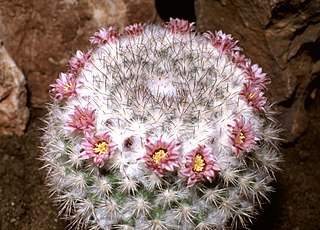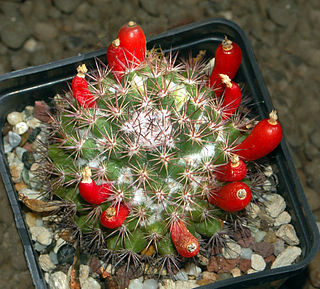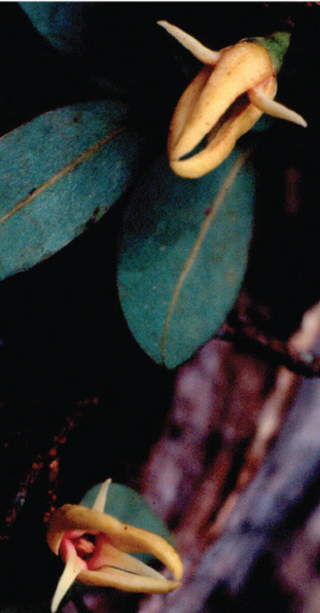
Mammillaria is one of the largest genera in the cactus family (Cactaceae), with currently 200 known species and varieties recognized. Most of the mammillaria are native to Mexico, but some come from the southwest United States, the Caribbean, Colombia, Venezuela, Guatemala and Honduras. The common name "pincushion cactus" refers to this and the closely related genus Escobaria.

Weberocereus is genus of cacti. It produces a green and white flower and is found mainly in Costa Rica and Nicaragua.

Catalpa bignonioides is a species of Catalpa that is native to the southeastern United States in Alabama, Florida, Georgia, Louisiana, and Mississippi. Common names include southern catalpa, cigartree, and Indian-bean-tree. It is commonly used as a garden and street tree.

Bougainvillea glabra, the lesser bougainvillea or paperflower, is the most common species of bougainvillea used for bonsai. The epithet 'glabra' comes from Latin and means "bald".

Cochemiea guelzowiana is a species of plant in the family Cactaceae. The species epithet guelzowiana honors the German cactus collector Robert Gülzow of Berlín.

Aeonium haworthii, also known as Haworth's aeonium or pinwheel, is a species of succulent flowering plant in the family Crassulaceae. It is grown as a houseplant in temperate regions. It has gained the Royal Horticultural Society's Award of Garden Merit, as has the cultivar 'Variegatum'.

Deutzia gracilis, the slender deutzia, is a species of flowering plant in the hydrangea family Hydrangeaceae, native to Japan.

Clarkia exilis is a small herbaceous annual plant of western North America. It is an uncommon species in the evening primrose family known by the common names Kern River clarkia and slender clarkia.

Brunfelsia latifolia, commonly known as yesterday-today-tomorrow and kiss me quick, is a species of flowering plant in the nightshade family. Endemic to Brazil, it is an evergreen shrub that becomes semi-deciduous in cooler areas and grows up to 1.8 meters in height.

Mammillaria grusonii is a cactus in the genus Mammillaria of the family Cactaceae. The epithet grusonii honors the inventor, scientist, industrialist and cacti collector Hermann Gruson of Magdeburg.

Mammillaria mammilllaris, common name woolly nipple cactus, is a species of plant in the family Cactaceae. It is the type species of the genus Mammillaria. It has been described by Carolus Linnaeus as Cactus mammillaris in 1753. The specific epithet mammillaris comes from the Latin mammilla, meaning nipple, with reference to the characteristic tubercles.

Asimina reticulata, the netted pawpaw, is a species of plant in the family Annonaceae. It is native to Florida in the United States.
Salix chingiana is a small tree in the willow genus Salix with dull purple-colored, bare branches. The stipules are permanent, the leaf blades are 7 to 10 centimeters long. The natural range of the species is in China.
Salix delavayana is a shrub or small tree from the genus willow (Salix) with mostly 3 to 8 centimeters long leaf blades. The natural range of the species is in the south of China and in Tibet.
Larsenianthus careyanus is a species of the ginger family (Zingiberaceae). It occurs in Bangladesh as well as northeast India. It is the type species of the genus Larsenianthus, which was newly established in 2010.
Larsenianthus assamensis is a species of the genus Larsenianthus in the ginger family (Zingiberaceae). It was first described in 2010 and is native to northeastern India.
Larsenianthus arunachalensis is a species of the genus Larsenianthus in the ginger family (Zingiberaceae).. It was first described in 2010 and is native to northeastern India.

Kalanchoe sexangularis, also known as bushveld kalanchoe, six-angled kalanchoe, or red-leaved kalanchoe, is a species of the succulent genus Kalanchoe, in the family Crassulaceae that is native to Southern Africa.

Uvariastrum insculptum is a species of plant in the Annonaceae family. It is native to Cameroon, Gabon, Ghana, Ivory Coast, Liberia, Nigeria, and the Republic of the Congo. Adolf Engler and Ludwig Diels, the botanists who first formally described the species using the basionym Uvaria insculpta, named it after the secondary veins on its leaves which are distinctly sunken.

Xylopia arenaria is a species of plant in the Annonaceae family. It is native to Kenya, and Tanzania. Adolf Engler, the botanist who first formally described the species, named it after its growth in sandy places.















